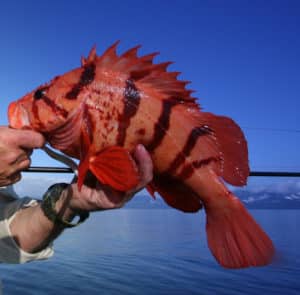Flamboyant Hawaiian
QUESTION:
I caught this oblique-banded snapper in deep water off Kona, Hawaii. I’ve noticed that a lot of the fish I catch from deeper areas—600 feet, and more in this case—seem to have rather showy color patterns. Because I would imagine it’s fairly dark down there, why would this be?
Steve Wozniak
Alamo, California
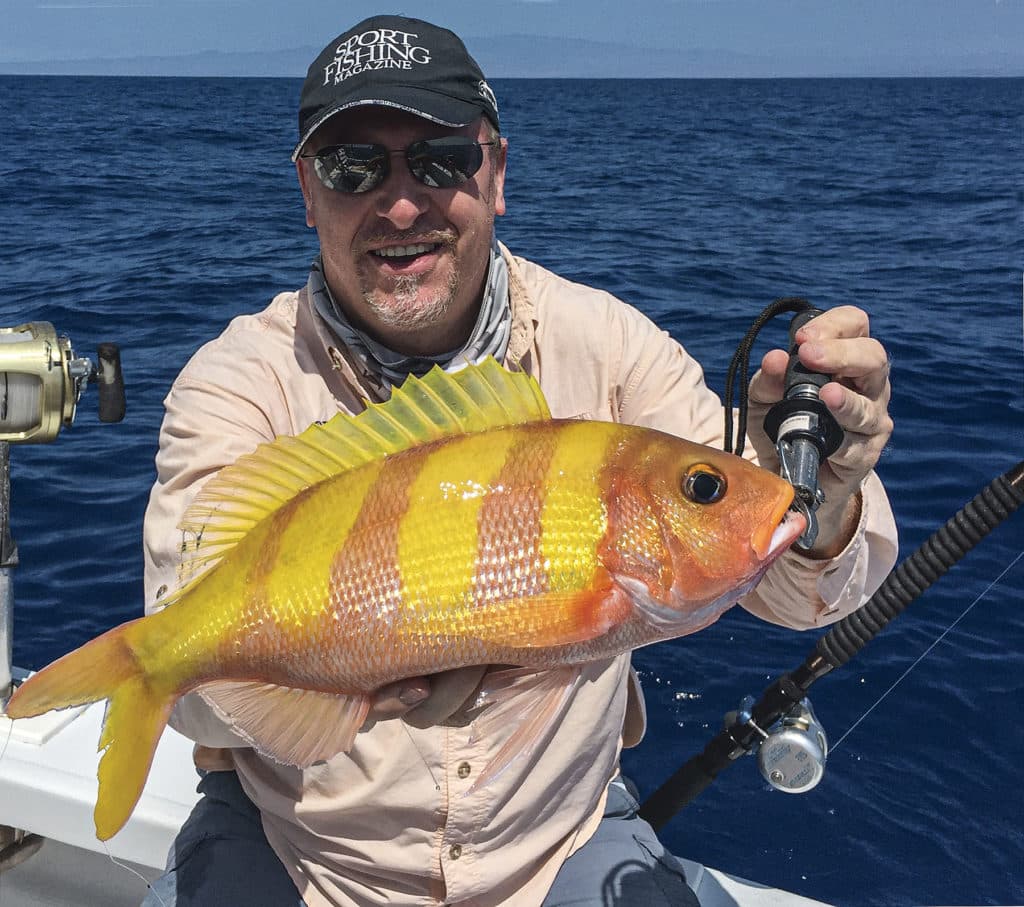
ANSWER:
Oblique-banded snapper or gindai (Pristipomoides zonatus) are members of the Etelinae subfamily of deepwater snappers within the family Lutjanidae. Other closely related members of the Etelinae, which also live in waters up to 1,000 feet deep in various locations throughout the Indo-Pacific, include ruby snapper (Etelis coruscans) yellowstriped red snapper (Etelis -carbunculus), and the pink snapper (Pristipomoides filamentosus). All of these fish have something in common: a predominately reddish or pink body color. Short wavelengths such as red are the first parts of the visible light spectrum to disappear when sunlight penetrates water (which is partially why deep, clear water appears blue or purple). This means red-colored fish are effectively camouflaged once water depths exceed around 100 feet or so, becoming virtually invisible in deeper waters as the wavelengths reflecting off their bodies become non-existent. However, both gindai and adults of some other species of Pristipomoides (e.g., goldflag snapper, Pristipomoides auricilla) contrast their bland uniformly pink background coloration with almost-fluorescent bright yellow bands (in the case of gindai) or dots (goldflag snapper). “Showy” is a good description. As to why this has evolved, Steve, perhaps these contrasting colors aid in communication and species recognition down there, helping out with stuff such as schooling and finding mates, but ultimately, we really don’t know.
—Ben Diggles
Alien From the Arctic Abyss
QUESTION:
We caught this fish along with redfish (deepwater Sebastes, not the inshore drum) and Greenland halibut in northern Norway, fishing in about 2,400 feet of water. (Without electrics—seriously!) What can you tell me about it?
Magnus Gunnarrson
Miami
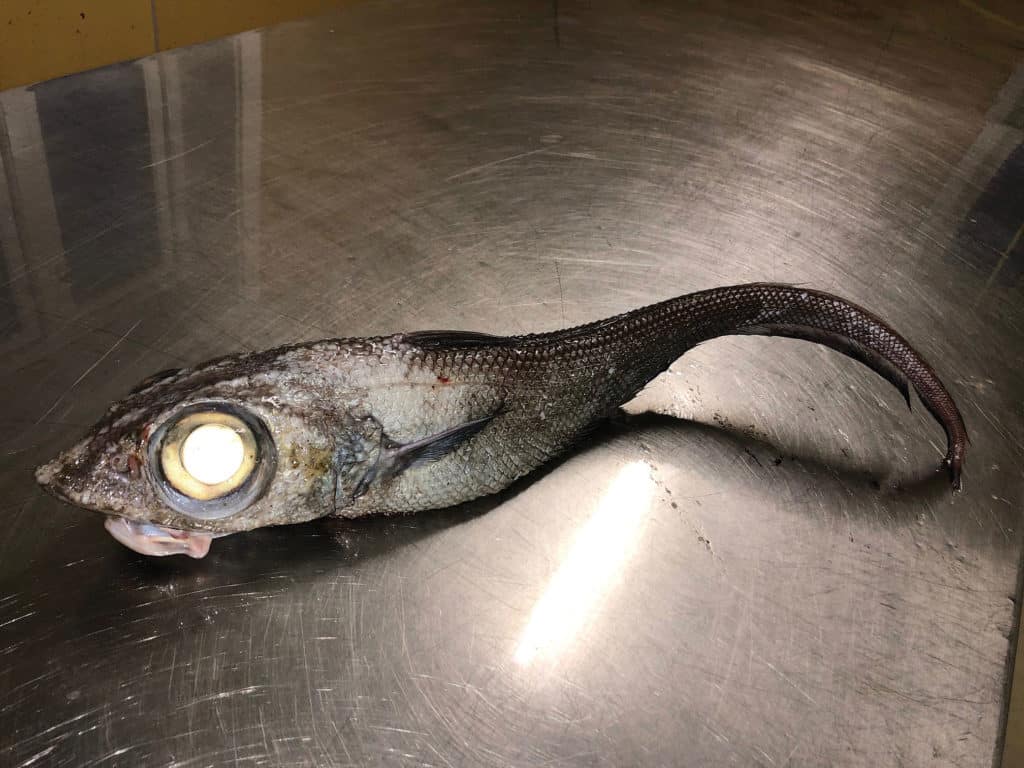
ANSWER:
Your fish is one of the grenadiers, or rat-tails. Specifically, it’s a roughhead grenadier, Macrourus berglax (note the spiny ridges on top of the head). It’s a benthopelagic species, occurring at depths of 300 to more than 3,000 feet, with an interesting geographical distribution, occurring from Spitzbergen to mainland Norway in a narrow band, and to the Faroes, Iceland, southern Greenland, and finally in the western North Atlantic from the Labrador Sea to Georges Bank (Norfolk Canyon). This grenadier’s diet includes benthic fishes, shrimps, amphipods, ophiurids and polychaete worms. Commercially, roughheads are caught as bycatch by trawlers fishing primarily for redfish (Sebastes marinus) or Greenland halibut. It’s one of the few grenadiers for which we know a little bit about reproduction. Females can lay up to 25,000 eggs. Spawning aggregations have been observed off Norway in depths of 2,300 to 2,500 feet. It appears that the species can reach up to 3 feet or so (but only about 5 pounds because so much is tail). Not surprisingly, no specimen has been submitted to the IGFA, so there remains no all-tackle record for the species.
—Mike Fahay
Porgy From Gibraltar
QUESTION:
On a recent trip to Gibraltar, I caught several of these interesting little fish in 600 to 700 feet, though close to shore. I think they are one of the many species of bream that are caught throughout the Mediterranean. Can you confirm exactly which species it is?
Dave Lewis
Wales, UK
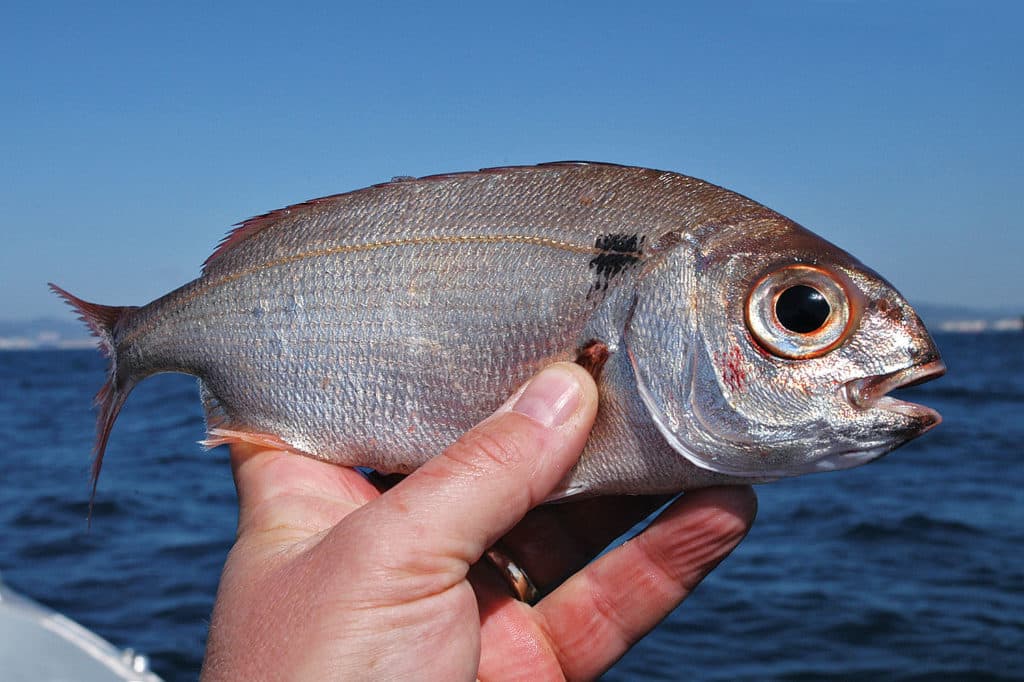
ANSWER:
Based on what I can see in your photo, I believe your catch is Pagellus bogaraveo, the blackspot seabream, Dave. This fish belongs to the family Sparidae, members of which are commonly called porgies. The blackspot seabream is found from Iceland and Norway south to Mauritania, including the western Mediterranean Sea and various island groups. It inhabits depths from 500 to 3,000 feet, with the young staying closer to coasts than adults. It is a protandrous hermaphrodite, changing gender from male to female during its lifetime. The blackspot seabream is an important commercial species that grows to a length of slightly over 2 feet, although most individuals are less than half that size.
—Ray Waldner
Read Next: Strange Fishes from the Deep: Gillbacker Sea Catfish and More
Sport Fishing’s Prestigious International Panel of Experts
Northeast: Mike Fahay, Sandy Hook Marine Lab, New Jersey
Southeast: Ray Waldner, Ph.D., Palm Beach Atlantic University, Florida
Gulf of Mexico: Bob Shipp, Ph.D., University of South Alabama
West Coast: Milton Love, Ph.D., UCSB, California
Far Pacific: Ben Diggles, Ph.D., Queensland, Australia
Bluewater Pelagics: John Graves, Ph.D., Virginia Institute of Marine Science
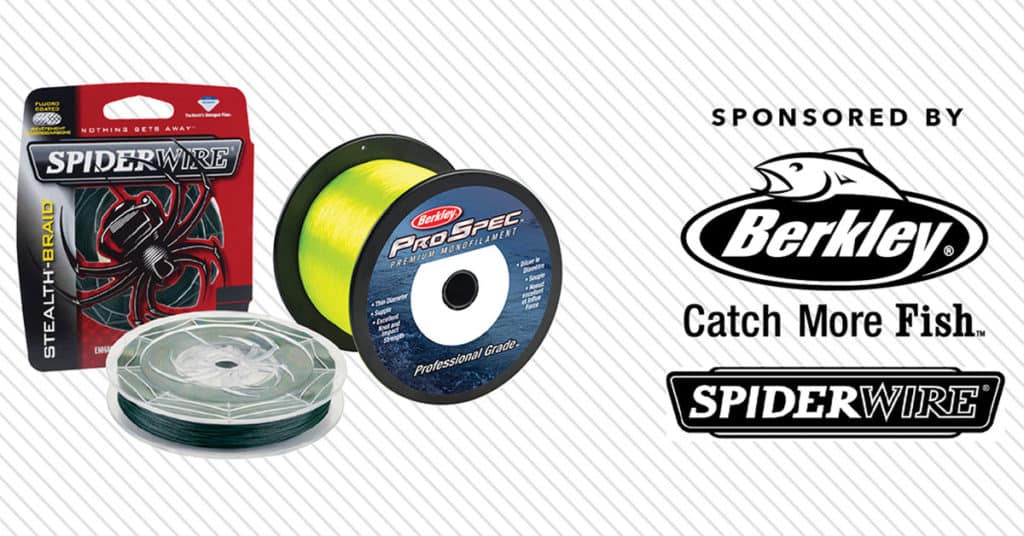
CHALLENGE OUR EXPERTS (And Win Up to 10,800 Yards of Line!)
Send in your question and any relevant photos of your mysterious catch or observation for our experts’ ID and feedback. If we publish your question and you have a shipping address within the United States or Canada, you’ll win a 3‑pound spool of Berkley Pro Spec ocean-blue or fluorescent-yellow monofilament (1,000 to 10,800 yards, depending on line strength) or a 1,500‑yard spool of Spiderwire Stealth braid up to 100‑pound‑test! Send questions and images via email to fishfacts@sportfishing.com (include your hometown) or via post to Sport Fishing Fish Facts, 460 N. Orlando Ave., Suite 200, Winter Park, FL 32789.

